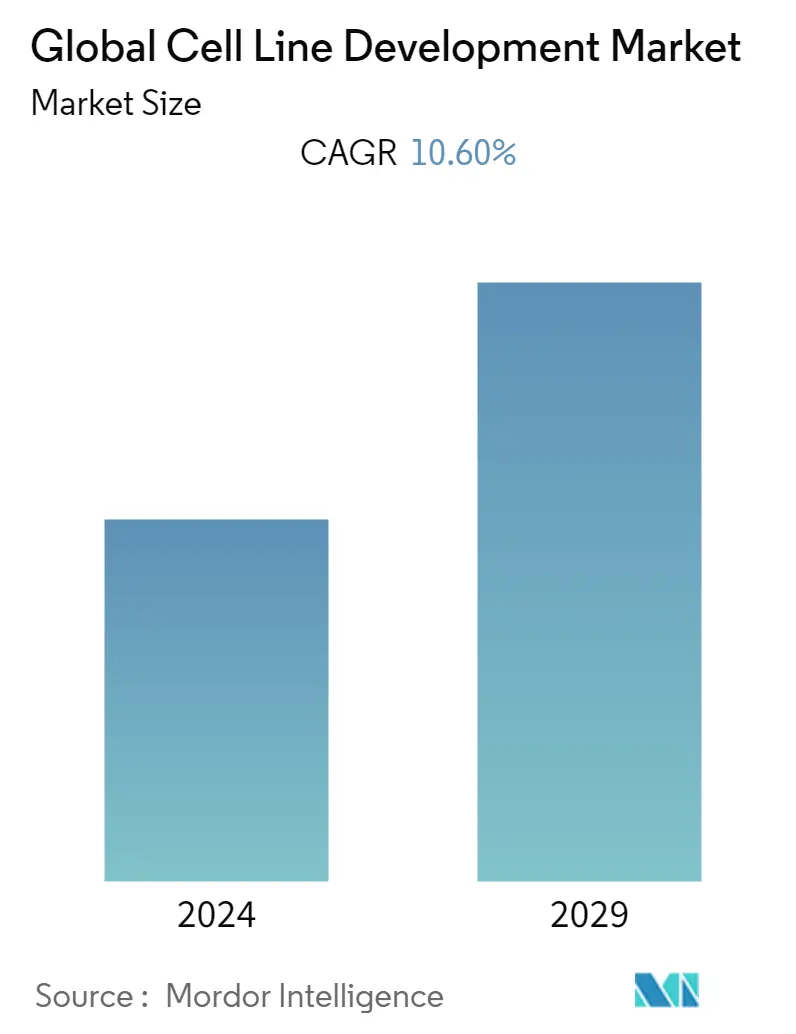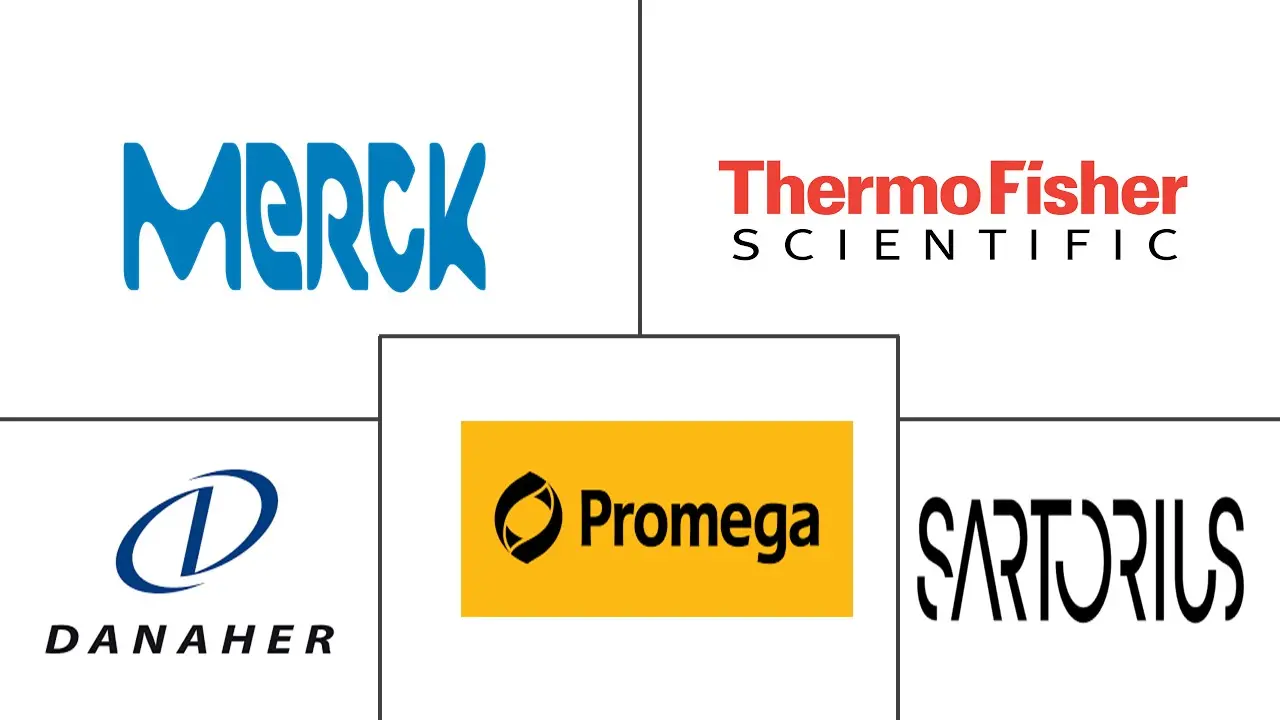Market Size of Global Cell Line Development Industry

| Study Period | 2019 - 2029 |
| Base Year For Estimation | 2023 |
| CAGR | 10.60 % |
| Fastest Growing Market | Asia-Pacific |
| Largest Market | North America |
| Market Concentration | Medium |
Major Players
*Disclaimer: Major Players sorted in no particular order |
Cell Line Development Market Analysis
Cell Line Development Market is poised to grow at a CAGR of 10.6% over the forecast period (2022-2027).
In March 2020, the World Health Organization (WHO) classified COVID-19 as a pandemic. Since that time, the mortality rate from chronic diseases has grown dramatically. As a result of the rising demand for vaccine development, COVID-19 is seen to have a positive effect on the cell line development industry. According to the study titled "Scientists develop suitable human cell line for anti-SARS-CoV-2 drug screening" published in the Journal of Virus in March 2022, Researchers have described the creation of a suitable human cell line for the high-throughput testing of antiviral medications that target the coronavirus 2 that causes severe acute respiratory syndrome (SARS-CoV-2). Angiotensin-converting enzyme 2 (ACE2) and transmembrane serine protease 2 (TMPRSS2), two essential host proteins required for viral entry, were engineered to express high levels in the human lung carcinoma cell line A549. As a result, more cell lines are being developed to manage COVID-19, which had a significant impact on the market under study during the pandemic.
The market is driven by the growing biopharmaceutical industry, rising demand for monoclonal antibodies and cancer therapeutics, and growing production of biosimilars due to the patent expiry of branded therapeutics.
Due to changes in dietary practises, a lack of physical activity, and general changes in lifestyle, cancer has become more prevalent over the past ten years. In addition, the demand for cell line development will rise as vaccine production expands and technology advances. According to the GLOBOCAN 2020 report, the total number of people in the world affected by cancer in 2020 accounts to around 19.29 million cases. The number is estimated to rise to 28.89 million cases by 2040. The use of cell lines in the production of biological cancer drug substances is increased due to increasing in cancer burden hence the cell line development market is expected to grow over the projecting period.
Moreover, growing production of biosimilars due to the patent expiry of branded therapeutics is expected to drive the growth of the market. cell line development play an important role in manufacturing and development of the biosimilars. Biosimilars increase market competition and facilitate patient access to life-saving medications. The primary objective of biosimilar producers is to lower treatment costs. For instance, according to the study titled "Expected Impact of Biosimilars on the Pharmaceutical Companies" published in the Iranian Journal of Medical Science in September 2021, In the markets of France, Germany, Italy, Spain, and the UK, patients now have a 44% greater access to these products as a result of the introduction of biosimilars in the European Union (EU). Therefore, it is anticipated that the development of biosimilar products will increase, making therapeutics more accessible to the individual and accelerating market growth. Moreover, growing launch of the biosimilars expected to accelerate the market growth. For instance, in June 2022, Biogen and Samsung Bioepis reported that Byooviz (ranibizumab-nuna) has been launched on the United States market as ophthalmology biosimilar.Thus, increasing biosimilar launches and patent expirations both had positive effects on market growth.
The above-mentioned statistics indicate the high burden of cancer across the world, which is expected to drive the growth of cell line development market, as there is been an increasing demand for the novel therapeutics to deal with cancer.
Cell Line Development Industry Segmentation
As per the scope of this report, the cell line development market includes the types of equipment that have been used in the process along with the source from where the cell is extracted. Furthermore, the market studied includes different types of cell lines and the end users of the same. The Cell Line Development Market is segmented by Product (Reagents and Media, Equipment, Finished Cells, and Other Products), Source (Mammalian Cell Line, Non-mammalian Cell Line), Application (Recombinant Protein Expression, Hybridomas Technology, Vaccine Production, Drug Discovery, Other Applications) End User (Biotech and Pharmaceutical Companies, Academics and Research Institutes, Other End Users) and Geography (North America, Europe, Asia-Pacific, Middle East & Africa, and South America). The market report also covers the estimated market sizes and trends for 17 different countries across major regions, globally. The report offers the value (in USD million) for the above segments.
| By Product | |
| Reagent and Media | |
| Equipment | |
| Finished Cells | |
| Other Products |
| By Source | |
| Mammalian Cell Line | |
| Non-mammalian Cell Line |
| By Application | |
| Recombinant Protein Expression | |
| Hybridomas Technology | |
| Vaccine Production | |
| Drug Discovery | |
| Other Applications |
| By End User | |
| Biotech and Pharmaceutical Companies | |
| Academics and Research Institutes | |
| Other End Users |
| Geography | ||||||||
| ||||||||
| ||||||||
| ||||||||
| ||||||||
|
Global Cell Line Development Market Size Summary
The cell line development market is experiencing significant growth, driven by the expanding biopharmaceutical industry and the increasing demand for monoclonal antibodies and cancer therapeutics. The market's expansion is further fueled by the rising production of biosimilars, a trend accelerated by the patent expirations of branded therapeutics. The COVID-19 pandemic has also positively impacted the market, as the demand for vaccine development has led to the creation of new cell lines for antiviral drug testing. The prevalence of chronic diseases, particularly cancer, has been rising due to lifestyle changes, which in turn is boosting the demand for cell line development to produce biological cancer drug substances. The development of mammalian cell lines, which are crucial for creating complex proteins and customized medications, is expected to see profitable growth, enhancing the production of monoclonal antibodies used in treating various chronic diseases.
North America leads the cell line development market, supported by a robust healthcare infrastructure and significant investment in research and development activities. The presence of key industry players and government support in the United States further propels market growth. The high incidence of chronic diseases, such as cancer, coupled with technological advancements in cell line development, contributes to the region's dominance. The market is moderately competitive, with major players like Thermo Fisher Scientific, Sartorius AG, and Merck KGaA driving innovation and increasing competitive rivalry. Collaborations and investments, such as those by ProBioGen and FUJIFILM Corporation, are enhancing manufacturing capabilities and expanding services, further propelling market growth.
Global Cell Line Development Market Size - Table of Contents
-
1. MARKET DYNAMICS
-
1.1 Market Overview
-
1.2 Market Drivers
-
1.2.1 Growing Biopharmaceutical Industry
-
1.2.2 Rising Demand for Monoclonal Antibodies and Cancer Therapeutics
-
1.2.3 Growing Production of Biosimilars Due to the Patent Expiry of Branded Therapeutics
-
-
1.3 Market Restraints
-
1.3.1 Strict Regulations
-
1.3.2 Time Taking Process
-
-
1.4 Porter's Five Forces Analysis
-
1.4.1 Threat of New Entrants
-
1.4.2 Bargaining Power of Buyers/Consumers
-
1.4.3 Bargaining Power of Suppliers
-
1.4.4 Threat of Substitute Products
-
1.4.5 Intensity of Competitive Rivalry
-
-
-
2. MARKET SEGMENTATION (Market Size by Value - USD million)
-
2.1 By Product
-
2.1.1 Reagent and Media
-
2.1.2 Equipment
-
2.1.3 Finished Cells
-
2.1.4 Other Products
-
-
2.2 By Source
-
2.2.1 Mammalian Cell Line
-
2.2.2 Non-mammalian Cell Line
-
-
2.3 By Application
-
2.3.1 Recombinant Protein Expression
-
2.3.2 Hybridomas Technology
-
2.3.3 Vaccine Production
-
2.3.4 Drug Discovery
-
2.3.5 Other Applications
-
-
2.4 By End User
-
2.4.1 Biotech and Pharmaceutical Companies
-
2.4.2 Academics and Research Institutes
-
2.4.3 Other End Users
-
-
2.5 Geography
-
2.5.1 North America
-
2.5.1.1 United States
-
2.5.1.2 Canada
-
2.5.1.3 Mexico
-
-
2.5.2 Europe
-
2.5.2.1 Germany
-
2.5.2.2 United Kingdom
-
2.5.2.3 France
-
2.5.2.4 Italy
-
2.5.2.5 Spain
-
2.5.2.6 Rest of Europe
-
-
2.5.3 Asia-Pacific
-
2.5.3.1 China
-
2.5.3.2 Japan
-
2.5.3.3 India
-
2.5.3.4 Australia
-
2.5.3.5 South Korea
-
2.5.3.6 Rest of Asia-Pacific
-
-
2.5.4 Middle East and Africa
-
2.5.4.1 GCC
-
2.5.4.2 South Africa
-
2.5.4.3 Rest of Middle East and Africa
-
-
2.5.5 South America
-
2.5.5.1 Brazil
-
2.5.5.2 Argentina
-
2.5.5.3 Rest of South America
-
-
-
Global Cell Line Development Market Size FAQs
What is the current Global Cell Line Development Market size?
The Global Cell Line Development Market is projected to register a CAGR of 10.60% during the forecast period (2024-2029)
Who are the key players in Global Cell Line Development Market?
Promega Corporation, Danaher Corporation, Sartorius AG, Thermo Fisher Scientific and Merck KGaA are the major companies operating in the Global Cell Line Development Market.

